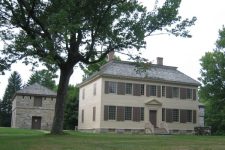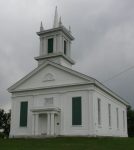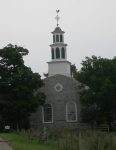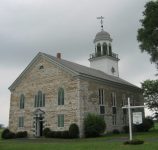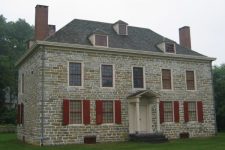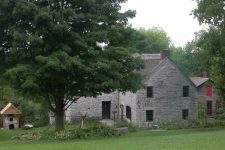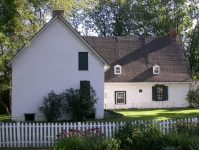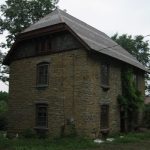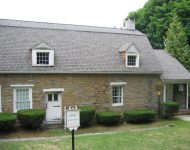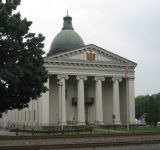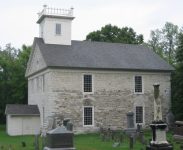UEL Bus Trips
Loyalist Bus Tour Organizers Extraordinaire George Anderson and Edward Kipp are conducting another Loyalist Mohawk Valley Trip October 1 to 4, 2006. The tour is limited to 55 people (7 seats are booked as of Sept 27, 2005). Rodney Craig and Douglas Grant are assisting with registration.
The bus trip will begin in Ottawa with pickups in Ottawa and Cornwall. The tour will visit twelve sites. In addition the bus will pass many other sites each day for you to take pictures..
The initial part of the trip will travel through the area of Eastern Ontario which was originally known as Lunenburg or the Old Eastern District. As the bus proceeds south to the St. Lawrence River it will traverse Loyalist Dundas County passing through the district formerly known as Williamsburg Township (now South Dundas). This is where Late Loyalist John McIntosh discovered the now world famous McIntosh Apple at Dundela. The bus will pass St. Peter Lutheran Church which was founded by Palatine Loyalists. The trip will also pass by the home of the world famous foot Doctor Mahon Locke who was descended from the Loyalist Doran Family.
The bus will then move along the St. Lawrence River east to Cornwall. This area along the river was known as the Front and eight of the Townships fronting on the river were known as the Royal Townships. Mostly Palatine soldiers from the First Battalion of the King's Royal Regiment of New York settled in the area west of Cornwall.
At Riverside Heights the people will see two churches from the bus, St John Lutheran Church and Holy Trinity Anglican Church. Loyalist families founded St John Lutheran Church. The burial stones of the Crysler Family and of Captain John Munro of the First Battalion of the King's Royal Regiment of New York are in Holy Trinity Cemetery. The tour will then pass Crysler Farm Battlefield Park and Upper Canada Village.
The Crysler Farm Battlefield Park celebrates the battle of Crysler Farm in which many Loyalists and their sons fought against the invading American Army in 1813. Upper Canada Village is a recreated 1860 pioneer villages which contains several original Loyalist buildings. It also contains the Pioneer Memorial which contains the gravestones from eight cemeteries which were flooded by the St. Lawrence Seaway. The village also contains a memorial which honours the Loyalists.
The bus will pass over Hoople Creek and pass the Union Cemetery. Hoople Creek is named after Loyalist Henry Hoople. Major James Gray of the First Battalion of the King's Royal Regiment of New York is buried in the Union Cemetery.
The tour will then pass through the Lost Villages Museum at Ault Park. This museum contains buildings, memorabilia, equipment, genealogical material and pictures from the six lost Loyalist villages which were flooded by the St. Lawrence Seaway. We will then pass by Maple Grove Cemetery where Loyalist Lieutenant Jeremiah French of the Second Battalion of the King's Royal Regiment of New York is buried.
Now we arrive in Cornwall (New Johnstown) which was founded by the Loyalist soldiers of the First Battalion of the King's Royal Regiment of New York under Sir John Johnson. Here there will be a pickup and a brief break at a local hotel.
The tour will now proceed over the Seaway Bridge to the United States and the Indian Reserve at Saint Regis which today is known as Akwesasne. The original land site of the Loyalists in Cornwall - Point Maligne will be pointed out from the bus.
Sir John Johnson and about 150 Loyalists fled from Johnson Hall, Johnstown in 1776 through the Adirondacks to St Regis. Today the bus will follow the route which Sir John Johnson took in reverse. You will also be able to enjoy the scenic fall colours of the Adirondack Mountains. We will have a buffet lunch at the Adirondack Hotel at Long Lake.
The tour will pause at the Johnstown Battlefield as we come into Johnstown. This battle was the last battle of the American Revolution. We will then visit Johnson Hall which was the home of Sir William Johnson and Molly Brant. Sir John Johnson also lived here before he fled to Canada.
Click on the photo thumbnails |
The next stop will be the Johnstown Historic Quadrangle. It contains the grave of Sir William Johnson and several historic sites. The Fulton County Courthouse is where Sir John and his Scottish retainers had to surrender their arms to the rebels in 1776. Its bell was rung when Walter Butler was killed at West Canada Creek. St. John Church was founded by Sir William Johnson. The Old Colonial Cemetery contains the some graves of Loyalist forebears.
The bus will now proceed to the Holiday Inn where we will stay for the next three nights and have buffet dinners and breakfasts.
The next day the tour will pass through Ephratah on its way to Snell's Bush Church. You will pass a stone grist mill in Ephratah which Sir William Johnson built. We will also pass through Keck's Corners where the Loyalist Vankoughnet Family lived. Snell's Bush Church was originally founded by ancestors of Loyalists. Here the first declaration of independence was made in the Mohawk Valley. The next stop will be Fort Klock. Some members of the Klock Family were Loyalists. Nearby Sir John's Yorkers fought the Battle of Fort Klock during one of his raids into the Mohawk Valley. The tour will then proceed to the historic Saltman Inn in Ephratah for a buffet lunch. After lunch the trip will visit Nellis Tavern. Loyalist Henry Nellis is descended from this family. Afterwards we will pause by the Old Palatine Church which was built on land granted by the Nellis Family.
The bus will then pass Fort Wagner. We will then go by the Fort Frey historic site in Palatine Bridge on our way to Stone Arabia. At Stone Arabia visits will be made to Trinity Lutheran Church and the Dutch Reformed Church. People will also be given time to explore both cemeteries. The bus will now meander through the countryside past an Amish Community back to Johnstown. In Johnstown it will pause by the historic Knox Mansion, Jimmy Burke's Tavern and Fort Johnstown. The Knox Family developed Knox gelatin. the historic Jimmy Burke's Tavern is the home of the local branch of the Daughters of the American Revolution. During the 1999 Loyalist tour, the Daughters of the American Revolution and the Loyalists enjoyed tea and a friendship cake here. Fort Johnston was build by Sir John Johnson and used by the rebels during the American Revolution. The day will end at the Holiday Inn. A noted speaker will speak to the Loyalists during dinner on the second or the third night of the tour.
The third day of the tour will begin with a pause at Bultersbury, the original home of Loyalist Colonel John Butler. The first stop will be Fort Johnson which was the second home of Sir William Johnson on the north side of the Mohawk River. Afterwards the trip will pass by the site of the home of Loyalist Daniel Claus and the home of Loyalist Guy Johnson. There then will be a pause at the Glen Sanders Mansion. This house was originally built in1659. Due to soil erosion it was dismantled and rebuilt in 1713.
We will now proceed to the Stockade District of Schenectady to visit the original Teller House and the Schenectady Historical Society, and to enjoy a walking tour of the historic Stockade District. The Stockade District is where Schenectady was originally founded in 1661 by Arent Van Curler. The French and Indians burned it and massacred most of the inhabitants in 1690. The Johannes Teller House was built about 1740. Some of the many other historic houses in this area are the Van Antwerp, Yates, Swits, Fonda, Vrooman, Van Slyk, Sanders, Glen, Brouwer, Kendall, Mabee, Bradt, Veeder and Marcellis houses. All of these houses date back to the 1700's. St. George Church which was founded by Sir William Johnson is also in the Stockade District. You can still sit on the site of his original pew in a later church which was rebuilt on the site. The congregations of several other churches such as the Dutch Reformed Church date back to early Schenectady. You will be able to enjoy a buffet lunch at the Stockade Inn which is built on the site of the original Van Curler home.
After lunch the bus will pass by the Vale Cemetery. Here the victims of the 1669 Schenectady Massacre were re-buried. The grave of Clarissa Putnam is also here. She was Sir John Johnson's first love. The bus will now pass close to the Van Slyk Family Cemetery on its way to now visit the Mabee Farm Historic Site. Here you will see the original three hundred year old Dutch house with original furnishings, a 1760's Dutch barn and the family graveyard where about twenty family members are buried. Some of the family were Loyalists.
Afterwards we will pass by the original Clarissa Putnam Home, Queen Ann Parsonage and Schoharie Creek area. Clarissa Putnam lived in the Putnam house after she and Sir John Johnson each went their separate ways. Queen Ann Parsonage was the home of Loyalist Reverend John Stuart. The Schoharie Creek area contains plaques to Fort Hunter, the East Indian Castle and Queen Ann Chapel. The communion set from Queen Ann Chapel was taken to Canada during the Revolution. Sir William Johnson's first Mohawk home at Warren's Bush was said to be east of Schoharie Creek.
The final visit of the day will be at the Van Alstyne Homestead in Canajoharie. This house was built by Martin Van Alstyne in 1749. Nicholas Herkimer received his brigadier general commission in this house. The tour will then proceed to the Holiday Inn passing by the area known as the Noses. Sir Johnson's forces camped on the southern Nose during this 1780 Mohawk Valley raid.
After breakfast on the last day of the tour, the bus will pause by the Montgomery County Archives and the Fort Herkimer Church. The archives are an excellent source of Mohawk Valley genealogical information. The Fort Herkimer Church is featured in the historical novel and film "Drums Along the Mohawk." The last visit will be the Oriskany Battlefield Historic site. Here you will receive an account of one of the bloodiest battles of the American Revolution where brother fought brother. Lunch will be at the Plainsville Farm Restaurant. The next stop will be the duty free and then onto Cornwall.
From Cornwall the bus will head back to Ottawa through historic St. Andrews West. St Andrews West is where the Loyalist son and famous explorer, Simon Fraser is buried. Loyalist Captain Miles Macdonnell is also resting here along with other Loyalists.
Any trip surplus will be donated to the Bernice Flett Scholarship Fund and the Loyalist Collection at Brock University.





